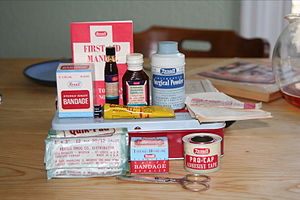We all have had to face emergencies at one time or another. Be it bruises, cuts, wounds or any other crisis, when it comes to dealing with a certain mishap, a first aid kit is the first thing to look for. This useful emergency kit helps cure common injuries, infections and illnesses’, hence keeping one handy is essential for all. Whether it is a home, office or school, a first aid kit must be present at all times. You can easily purchase it online or through retailers but in case you plan to prepare a first aid kit on your own, consider the following dos and don’ts;
Making a First Aid Kit: The DO’s
- 1. Select the Right Container
Once you have determined the type of use and the users of your first aid kit, you should select a right sized container. All the items should conveniently fit in the first aid kit box. Not only should it be big enough to store all the items, but it should also be easy to carry around. Hence, the container should be both light weight and handy.
- 2. Divide the First Aid Kit into two sections
One section should consist of all the basic medical supplies that one might need, for example bandages, scissors, ointments and anti-septic products. The other section can contain other vital medications the family members might need, or are prescribed to.
- 3. Regularly Check the items for Expiry
All the items in a first aid box should be sterile. Also, one should regularly check the medications for expiry. Expired items should be replaced with new ones without any delay. The material in the kit includes;
- Adhesive dressings and bandages for various shapes and sizes.
- Gauze pads of different sizes. In case they are too big, you can always cut them into half.
- Scissors
- Antibiotic or anti-septic ointment to keep infections away.
- Cotton pads or cotton balls
- Wipes, for cleaning external surfaces
- Tweezers and sewing needles
- Thermometer
- Bee-sting kit
- Gloves
- Sterile dressings
- Insect repellant
- CPR breathing mask
- Saline Water
- 4. Make it Easily Accessible
The first aid kit should be easily accessible for all the adults at home. The kids should also be given training about how and when to use the kit but make sure you keep it away from infants. Even guests who frequently visit your place should know where the first aid kit is placed.
- 5. Make a Checklist
A checklist should be made of all the items present in the first aid kit. While checking the first aid kit for all essential items, you can always match it with the checklist. The unchecked items can then be bought easily without any confusion. Your checklist should look something like this;
Bandages
- Adhesive dressings
- Gauze pads
- Band-Aids
- Adhesive tape
- Roller bandages
- Sterile dressings
- Triangular bandages
Medications
- Essential medication for the family
- Antibiotic ointment
- Sanitizer
- Insect repellent
- Bee sting kit
- Sterile saline
Tools
- Container
- Cotton balls
- Scissors
- Sewing needle
- Gloves
- Tweezers
- CPR breathing mask
- Thermometer
Making a First Aid Kit: The DON’Ts
- Don’t forget to check the items for their expiry dates after every use.
- Don’t let the supplies run out or get low so check the contents of the kit from time to time!
- Don’t forget to wash the equipment after every use. The scissors, tweezers, thermometer, etc should be washed and sterilized over a flame after every use. Never pack up the tools without sterilizing or cleaning them.
- One should not keep prescriptions in a first aid kit. They might expire and not remain valid for all times. Only emergency items which are to be stored for longer time periods, their prescriptions can be stored.
- Do not use products consisting of natural rubber latex or NRL. These items may have deteriorating effects and some people might also be allergic to NRL.
Don’t use the items in the kit until and unless you are sure that you are not allergic to any of them.
Richard Hammond is a doctor working at one of the best hospitals in New Jersey. He writes about various precautions that can be taken in order to prevent or handle an illness for PhentermineDoctors.com. According to his patients, he always stresses on the fact that prevention is better than cure. In this article she discusses what to do and what not to do when making your own first aid kit.
[toggle title=”Featured images”]
[/toggle]
From the web
- Children at risk of AIDS should be tested at birth – UN (reuters.com)
- Home health tests: the rise in DIY diagnosis (theguardian.com)
- How are you #FacingAIDS (video) (aids.gov)
- ACA News Round-up (aids.gov)



Leave a Reply